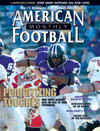AMERICAN FOOTBALL MONTHLY THE #1 RESOURCE FOR FOOTBALL COACHES
Article CategoriesAFM Magazine
|
Penn State Pass Rush Tecniquesby: Larry JohnsonDefensive Line Coach, Penn State University © More from this issue One of our basic philosophies as a defensive unit is to make the opponent one dimensional. We tell our defensive linemen ‘To earn the right to rush the passer, you must first stop the run.’ The last three years against the run, we ranked 4th in 2004, 2nd in 2005 and 2nd in 2006 in the Big Ten Conference and nationally ranked 34th in 2004, 7th in 2005 and 7th in 2006. We really sell to our players the importance of stopping the run and getting to the quarterback. To be a great defense against the pass, we feel it is important to be able to rush the quarterback with four down linemen without blitzing all the time. As a unit we take a lot of pride in making an effort to get to the quarterback. A four man straight rush may not be the answer all the time so we have to incorporate four man and two man games to improve our pass rus....The full article can only be seen by subscribers. Subscribe today!
|
|
|||||||
| HOME |
MAGAZINE |
SUBSCRIBE | ONLINE COLUMNISTS | COACHING VIDEOS |
Copyright 2025, AmericanFootballMonthly.com
All Rights Reserved





